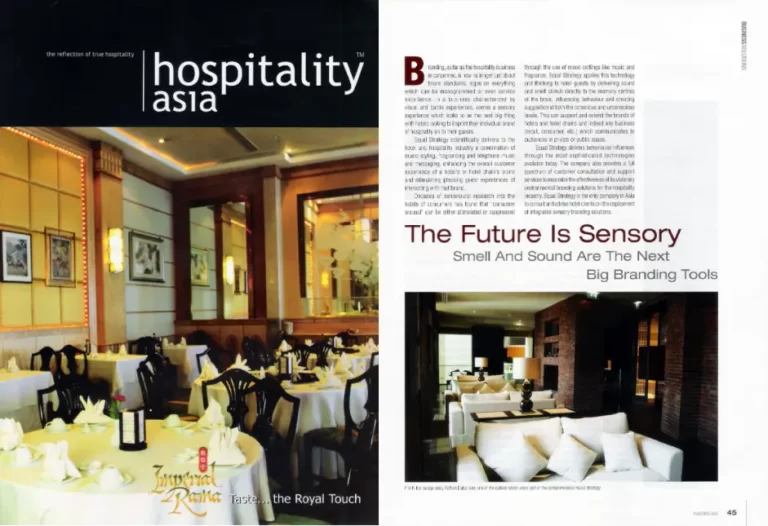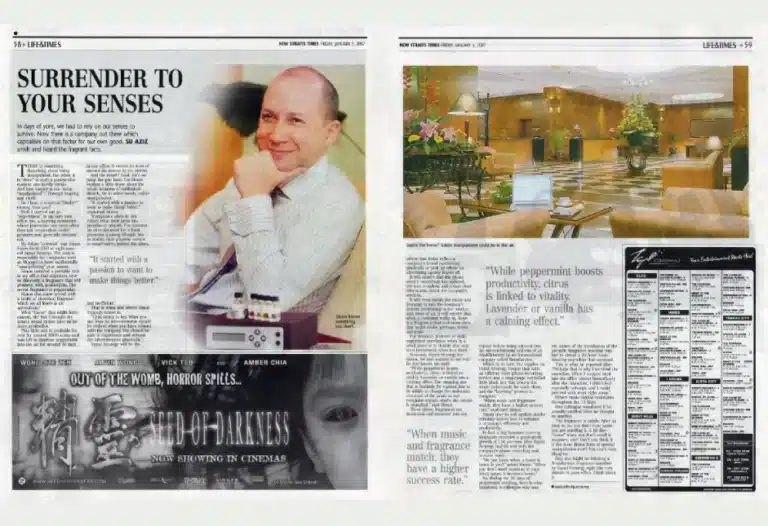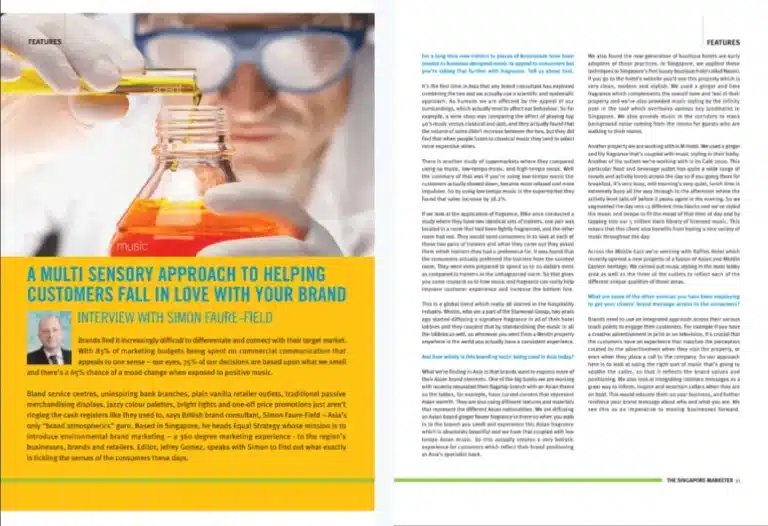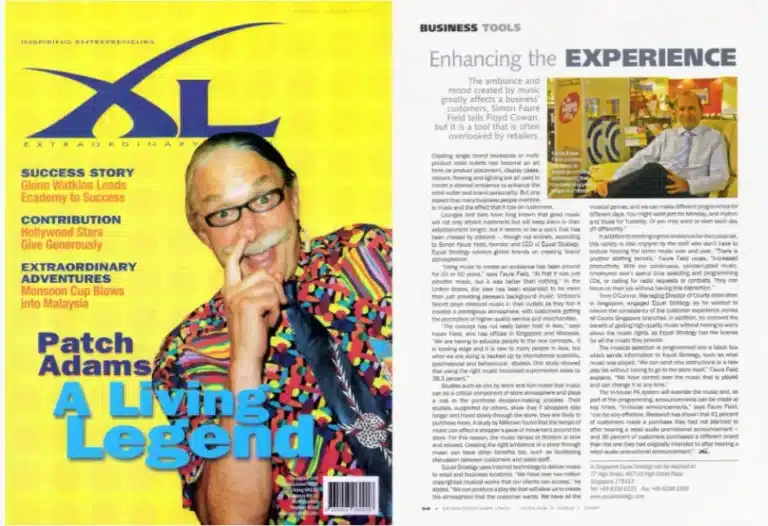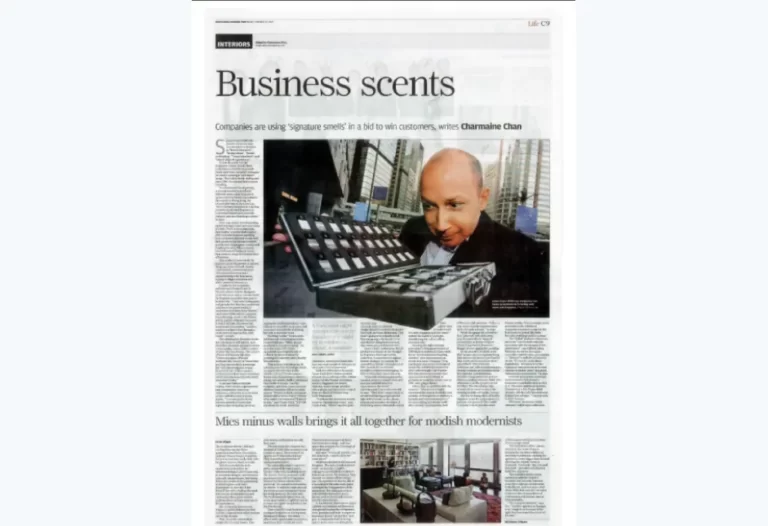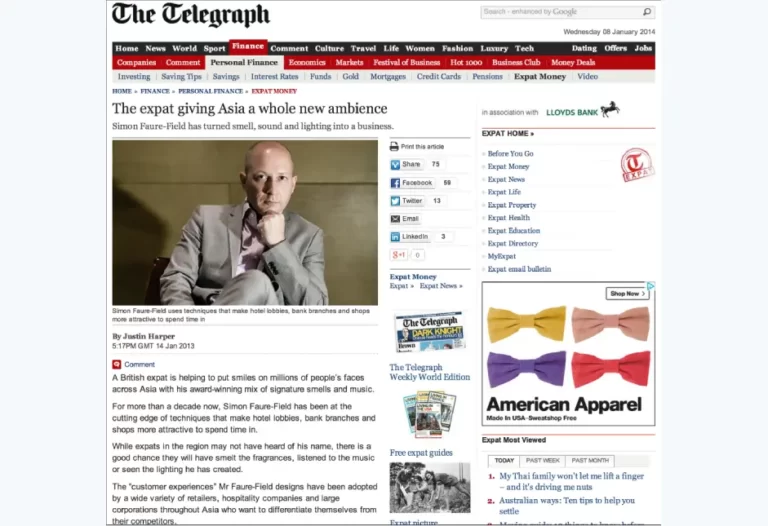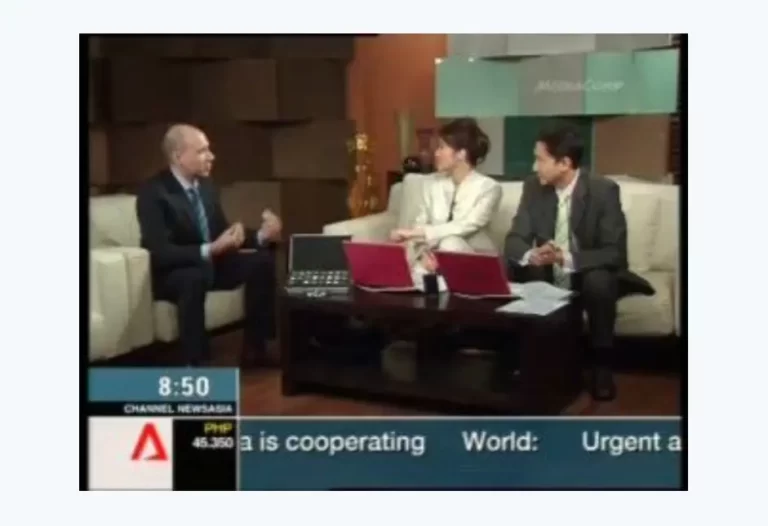Simon Faure-Field, CEO of Equal Strategy, speaks to 938 Live presenter Stanley Leong about how different kinds of background music and scent marketing create a mood for customers, which leads to longer durations of customer visits and results in an increase of higher sales revenue.
He shows how this multi-sensory approach enhances the overall customer experience. Find out what kind of background music and fragrance would fit your business.
Stanley: Welcome to the living room on 938 live with me Stanley Leong. It’s excellent that you can catch this conversation that is just about one full because our chance will certainly appeal to your very senses in more ways than one.
We want to talk about customer experience when shopping.
It is more than just the shop’s front door what’s in the window of the store catches your eye and beckons you to come in, have a look and possibly make a purchase.
More than just the eye retailers are increasingly appealing to passers by other senses other than visual. So, the next time you smell something in the air that is pleasantly sweet, warm, and inviting, don’t be surprised that you are led turn to the corner, walk into a shop, and buy something where you initially had no intention to.
That very shop that’s confusing the air with the costume-made fragrance. We will learn about the scents of sights? and smell. Some retailers also know that the auditor can also be a powerful sensual function that can turn someone who is nearly browsing into a customer.
That ‘yes thing’, the wallet thing’, that purse surely is not going to get into the way that caters to your sensory gift-a whole new meaning to the customer experience today. We will talk about turning on the potential customer in fascinatingly certain ways.
My guest is SimonFaure-Field. Simon is the CEO of a visionary customer experience consultancy called Equal Strategy.
He knows the business insight out of customer sensual marketing better than anyone else because his company specializes in compiling special background music playlists for stores, music tailor-made to suit their products and clientele in addition to the clients’ customized fragrances that are connected to air conditioning systems.
The has done consulting for the lives of MNCs and internationally known brands including Courts, Microsoft, Mercedes-Benz, OCBC Singapore and Malaysia , and even Changi Airport.
Turning up the music in the living room now on 938 Live. Simon, thank you for joining us today!
Simon: Good morning.
Stanley: Good morning. It’s going to be an exciting discussion. I already sense and smell it because it is just amazing how you can recap and grab the attention of that particular customer who does not even know that he or she is being drawn into a store and of course giving in the whole nature of wanting to spend and to spurge on things which they initially did not have the intention to. So, very interesting – music and also the power to scents.
Let’s find out how you got started and got interested in this specific area of marketing.
Simon: Back in 1998 we realized there was an opportunity in the marketplace where businesses tend to be neglecting the way they presented themselves through the telephone, they were spending substantial amounts of money on marketing and advertising campaigns in magazines and TV, all to generate phone calls and make customers’ contact then.
We found that when you picked up the telephone and called these companies, what you experienced when you were put on hold or you had to listen to any automated prompts or greetings, it tended not to reflect the company’s branding and its positioning in its marketplace.
So, there was an opportunity and need for us to provide a service that helps companies to professionalize and get that touch point more brand-centric.
We developed a way to look at using music and interlacing that with messages using professional voiceovers.
There is a way to inform, educate, and engage customers when they are waiting on hold. This helps to reduce abandoned calls. But if we take a brand-centric approach to the music and the voice so it reflects the company in the right way, it creates a more consistent experience for that customer.
Five years ago, we were invited to become a member of the On Hold Messaging Association in the States.
While I was in America I was introduced to a company that developed a technology for music in retail. They had quite a large music library. When I came back to Singapore, as soon as I got off the plane, and walked through Changi Airport, I could hear music. I was thinking about this music, does it really reflect Changi Airport’s brand and positioning? Does it create the right sort of mood in the environment?
Then I went around from the shopping centers to the hotels and it just dawned upon me that people just look at music just to have music without really looking at the mood it created in the environment.
Again we saw there was a similarity with how we were treating background music and messaging on the phone system.
There is a need again for us to fill this area and help companies create and environment that’s conducive for their customers, to help them really create an environment that customers like to go to.
If you like to go to a particular shop because it feels good to you, you have a natural preference to go there. If you are relaxed within the environment, you will actually spend more time there. When you spend more time in a store, it has been scientifically proven, you will spend more money. So, that was just looking at using music.
And then four years ago, I met a super branding guru, a gentleman by the name of Martin Lindstrom. He wrote the book “Brand Sense.” This covered multi-sensory branding. I met him at an event and he was talking about music and sound and how that has to fit within a branding context, which confirmed my beliefs all along.
Martin explained the use of fragrance and how the sense of smell is the most powerful sense that we have.
Stanley: Is it really the most powerful?
Simon: Yes, and you can’t ignore it. If you were to walk into a restaurant and it didn’t smell nice, no matter how nice it looked, no matter how beautifully the restaurant was arranged, you wouldn’t want to stay there.
Stanley: When we talk about restaurants smelling nice, are we talking about restaurants smelling like the great food that it produces from the kitchen or are we talking about really artificial fragrances just to make it pleasant
Simon: I’m just talking about smell in general. If this applies to retail outlets, if you went to a retail outlet and it didn’t smell nice, you wouldn’t want to stay there.
It’s human nature, the nose was actually developed to warn us of danger. We can now turn that around the other way.
If you can make an environment smell more appealing, it will be more attractive, and that’s to your consciousness and also to your subconsciousness.
Equal Strategy is helping companies to use fragrancing to help fit with their brand but also to make their properties more attractive, and more appealing.
There is a new hotel that’s going to be opening behind The Raffles Hotel. If you go along Seah Street, you find a lot of construction. In a couple of months, there will be a new hotel called Naumi Hotel and we are providing the background music in the lobby and the swimming-pool on the roof, but also frangrancing in the lobby as a way that when customers were within that environment, it’s going to sound good, it’s going to look beautiful but it’s going to smell beautiful as well.
We are creating a multi-sensory appeal, for the customers.
I can’t get into much detail about the type of fragrance we are going to use or the music, as we are developing the concepts.
Objectively, this hotel wants to create a very unique experience – It’s going to be Singapore’s first luxury boutique hotel.
So, when customers or guests visit, it will sound right, it will look good and will smell amazing. Because the sense of smell is directly connected to the brain’s center for emotions and memory – it will have a profoundly memorable effect on people.
Stanley: You feel good
Simon: You feel good. And if you feel good, you like to be there. So, it is not always about price being the drawing factor – retail has a very price-centric approach in Singapore.
You find at the top tier of the market, price tends to become irrelevant. It is about how the customer feels about the product and what we are trying to do is help the customer feel more comfortable, and relaxed within the last mile of purchasing of that product and looking at the product.
Stanley: Simon, you must have been asked that before that you know whether or not such marketing techniques are actually being manipulative. Because you know, customers aren’t really browsers, they could be browsers right at the start; they never had the intention to buy anything, at least walking into a store but suddenly they are attracted subtly unconsciously or subconsciously. So, would this be ethical in a sense?
Simon: Well, isn’t making a shop look beautiful or stylish the same? It’s about making it attractive, making it appeal to a customer and visual.
With stores being fitted out, and they spend a lot of money on the visual sense, right? What we are finding now is that visually we are overwhelmed.
If you look back in time in the 1960’s, which is before my time, people had about 30% recall of what they saw on television the previous day. Today, could you name five TV commercials that you saw yesterday?
Stanley: No.
Simon: Could you recall three advertisements that you read in the newspaper yesterday
Stanley: Yes…Potential Clients.
Simon: What we are actually looking at here is the ability to recall what we saw. This is rather looking at the effectiveness and there has been such a heavy focus on visual marketing.
Stanley: We are just bombarded.
Simon: We are just bombarded. We are overwhelmed and we can only remember or recall so much. So, by storekeepers making their stores look attractive they are trying to engage the customers in an area that’s already overwhelmed. So, that’s where we are coming in. We are helping with the ambient music and fragrancing to make that all more attractive, and more appealing.
Stanley: Overall experience.
Simon: And ultimately, research found we buy with our emotions, and justify with our logic. If we all bought purely on price, Mercedes Benz wouldn’t exist, BMW and Audi wouldn’t exist. Well, they do and that’s a growing part of the market. So, what people buy or spend their money on is a way for them to express themselves, and their status and about making them feel good.
If we can help that shopping experience to make them feel even better, then I think we are doing the right thing.
Stanley: Simon Faure-Field with us and he is CEO of Equal Strategy, a customer experience consultancy. Very interesting ways in which they help their clients, of course, draw in the crowds to the stores and of course help you open your wallets, purses and handbags – to make that purchase; how about that? And if you have a question for Simon, you are more than welcome to call in as we talk about brand atmospherics today in the living room. The number is 66911938.
Let’s continue to look at, you know, how organizations, businesses retail stores, and even hotels go about using fragrances. You have brought in a mini briefcase of dort, no documents or laptops in there but you have a little bit of a tray of scents and fragrances in small bottles, it looks very pretty there.
You were telling me that one of the hotel chains, The Marriot chain, actually uses a certain fragrance across all its hotels, not just in Singapore, across all hotels.
Simon: It’s a global initiative that kicked off about two weeks ago and Brandaroma, who is our fragrancing partner; they are one of the approved suppliers. So, we had a selection of six different fragrances that the hotels were allowed to choose. But also work with Shangri-La, who across all their business hotels in Asia have actually rolled out and used this fragrance for the last year as a way to represent Shangri-La’s mystic. Why don’t you have a smell of this?
Stanley: Hmm…how would you describe this? You are probably better describing things.
Simon: To make things simple, it’s very sophisticated, very up-market and it smells expensive. And what they wanted to archieve was ultimately that because that’s how Shangri-La’s brand is positioned.
If you were to travel to Raffles City, on the ground floor near the Prego restaurant there is an art gallery called Ode to Art and we recently installed our scent marketing system. Being an art gallery they are big ticket items and it’s a very sophisticated environment. What they wanted to use a fragrance that was very elegant and sophisticated as well.
Stanley: And I had a smell of that one. It smelled like a lady’s perfume.
Simon: That’s right.
Stanley: It smells very delicate, is it?
Simon: Exactly, right? These fragrances have a blend of between 20 to 45 different ingredients. This is a way actually to make a fragrance that doesn’t smell predominantly like pine or something very simple as it is very economical that you can find in a lot of these “squirt squirt” dispensers you have in a lot of different outlets. What we actually have here is a fragrance that’s very much nearly a fine fragrance. A lot of care has been put into creating these and we have a way where we can actually turn the liquid fragrance into a dry vapour, and pump that into the air-conditioning system.
By mixing with the air conditioning feed it enables us to provide a consistent fragrance level throughout the whole store or within the designated area. That’s what we have happening at Ode to Art.
Now if you were to visit Citroën (Cycle & Carriage), we have a fragrance, which is very fruity.
Stanley: This is Citroën as in the motoring company.
Simon: That’s right. What’s interesting, there was a study by Nike in the States and they had two identical sets of trainers, in two rooms next to each other, and they found that customers actually preferred the trainers that had been fragranced and were prepared to spend more money for the slightly fragranced trainers.
Not knowing that they had been fragranced but in their subconsciousness, they actually preferred the fragranced trainer to the un-fragranced and were prepared to spend $10-15 more.
Stanley: Very interesting. Fragranced our airwaves will be tempted to stay on with us …but definitely more aromatic conversation coming up in the living room and we will continue our chat with Simon Faure-Field on 938 Live. Stay tuned.
Jazzing up your day! Would Jazz be a good choice for your business, your retail store, your hotel reception…hmm, we will find out because in the living room today Simon Faure-Field is my guest and he is the CEO of visionary customer experience consultancy called Equal Strategy. You can visit them at www.equalstrategy.com.
He is in a business where they are able to help clients to pick out scents, smells, aromas that would actually complement their business, their brand, it’s called brand atmospheric.
It’s not only about what people smell but also about what people hear. We are talking about music as well in the living room for the remaining of this. And we will be finding out more about jazz. I mentioned about jazz a while ago. So, Simon, is jazz somewhat popular for businesses especially if they want customers to spend or stay longer?
Simon: Yes, it really depends on what that company is, who they are, what they are selling, and who their target customer is. And this sort of mood they want to create. So, people generally associate jazz with creating an up-market, sophisticated mood and atmosphere. For example, if a sports shop wanted to use music proactively to create the right mood and environment, I wouldn’t necessarily recommend jazz for something that has a lot of energy about it.
If you have an environment where you are catering to a segment of the market where people will be sitting around, having wine and cigars, then maybe jazz would complement that sort of environment. This is one of the factors that we have taken on board when we are talking to our clients.
For example Courts, in their electronic department, in their mega store, we use high-energy music because there is a lot of energy and adrenalin associated with technology. But when you go down into their furniture departments, the living room set, you want people to relax. You want people to slow down. And there we actually you low-tempo jazz and chill-out music, and that slows people down. We can use music tempo the same way to influence the flow of customers, to get them to slow down, relax, and unwind if that environment is what you want to achieve.
Stanley: I believe that you have an example about a supermarket as well?
Simon: Yes, that’s right. There was a study carried out by MBA undergraduates. Over a six-week period, they were looking into the effects of music and the impact that had on revenue. They tracked the number of customers entering the store, the speed they were moving around in the store, the number of items they purchased and how much money they spent.
They compared the effect of low-tempo music against high-tempo music, against no music at all.
They found that between high-tempo music and no music, there was a 4% variance in sales revenue. But when they looked at low-tempo music they found that the revenue actually increased by 38.2%.
And that’s a lot, phenomenal, if Cold Storage could increase their sales by 38.2%, I think they would be extremely happy, right?
Stanley: I think they could turn the plug.
Simon: The researchers looked into how that came about. They went through their data and realized when low-tempo music was played, customers moved at a pace slower than the music, they became more impulsive, they purchased more items and they spent more money.
Stanley: So, when they are moving slower, they become more impulsive – very interesting.
Simon: They are more relaxed. When you are relaxed, you are just following your mood, aren’t you? And you tend to be more impulsive.
Stanley: Very interesting. We also want to talk about banks because banks would be another group of clients that your organization consults for. What about banks, how do they sound like or smell like?
Simon: Okay…OCBC. We have some of their private banking branches. We have half a dozen in Malaysia at the moment. For the premier banking centres we provide classical and jazz music because it creates a very up-market and sophisticated mood. When you go up the elevator and you come out on the mezzanine floor and it’s for premier banking, it isn’t just a matter that you have a private banking logo there. It feels very sophisticated and up-market.
Stanley: It makes you feel like a high-networth individual.
Simon: That’s right. If you go down to the mass market, we are using music that appeals to a broader demographic. There is a lot more energy, a lot more fun. This is another way to help companies like OCBC create differentiation between their products and service offerings.
We are in discussions with one of the big Singapore banks. The strategy is to add an Asian element to their business through sound and scent. That’s a little project we are working on in the meantime. So, I can’t get into too much detail there.
Stanley: I will keep my ears and nose out for that when that happens. To be brand-centric, it’s got to be of course tailor-made scents and music. Talking about music, is very interesting, I just learned from you that you can’t play your own CD in a store, in a business setting.
Simon: Not unless you have the licensing for all the correct licenses in place. Something we found in the market is that there is a lack of awareness of music licensing. Even just to play a cd you need to have the performance rights licenses in place. To play music from an iPod, there sre multiple licenses, and permissions you are meant to have.
We found businesses in Singapore are unaware of this, and liable for a big slap on the wrists. You find elsewhere in the world, it is highly regulated and policed. So, one of the offerings of our LMM service is that we look after all the music licensing. We have a library of over 2.5 million licensed works of art.
We use a technology system that allows us to create playlists so we can schedule different types of music for different times of day. Depending on what type of business they are, we can actually interlace messages between music.
If you go to Courts, you will find that every ten minutes we have a very nice message that we’ll drop in between the tracks. It sounds like a radio station. This is another way they can communicate with their customers. Surveys have found that people, who have heard audio messages while shopping, are 40% more likely to make an impulse purchase. Even 36% are likely to choose an alternative branded product to the one that they actually intended to purchase.
Stanley: You just mentioned Courts and how they play promotional messages alongside music. How do you do that when it’s music, for instance, the customer would just be browsing and walking around the stores, enjoying music for the background function that it serves. When a promotional message is coming though, you assume the customer to pay attention to it. Is it able to play both functions effectively?
Simon: Yes, it’s about really making it work and not just treating it as a very high-impact commercial. For the messages, we craft scripts. We work with the leading professional voiceovers in Asia. It has a music bed in the background. So, it’s subtle but it is intrusive enough for people to notice and it is effective. It’s about having everything that works together. You can’t just have music and look at messaging as a totally different abstract element. Everything needs to jive and work together. Everything needs to complement each other.
Stanley: Have you dealt with clients where you have not only helped them select the fragrance but also complemented it with music?
Simon: Definitely, early this year we won our first American account, which was Pan Pacific. They opened a property in Seattle and they wanted a particular mood within the hotel lobby and the bar. We created a custom music playlist for the brand, which was designed around the type of mood at the time they wanted to create it in that environment.
We also have clients here in Asia who we are doing that for as well. So, it’s about trying to drill down into defining what they want from the environment, how is the brand positioned, and how can we use music and fragrancing to work in synergy together.
Equal Strategy is the only company in Asia that provides music and fragrancing in synergy to stimulate customer experience.
Stanley: To be an organization that would have tailor-made music and also tailor-made scents created for you. Can you actually protect that particular scent and the 40-50 ingredients that are going in the scent as your own signature scent? Also, the music playlist you put together for them?
Simon: Definitely, from a fragrancing perspective that can be a signature fragrance for a client, which means no one else can use it. To actually replicate a fragrance 100% is virtually impossible. So, someone may have replicated about 97-98% working very closely probably with some of the finest perfumers in the world. But fragrancing is very difficult to replicate 100%.
On the music angle, we have such a broad diverse range of music. But a major proportion of this isn’t available for people on the street. It’s industry-specific. So, creating a music playlist, it would be very difficult for someone to replicate unless they have access to our broad range of different music libraries. Again it is extremely difficult for someone to replicate.
Stanley: Let’s assume that in business we have to be interested in wanting to find out more about creating its own tailor-made scent and music playlist. If they come to you, what information would you require of them to be able to sort out, what really would fit them?
Simon: We would find out what they are trying to do with their business, where they are going, how they are perceived in the marketplace, and how they want to be seen as opposed to how they are seen can be two different perspectives, find out more about their business, what they want to be doing. Then we would look at music and fragrances. From there work back from the brand as well and find out how these different elements can work in tandem together. So, it isn’t as simple as walking into McDonald’s and purchasing a Big Mac, and walking out with the product.
What we do is tailor-made to each and every individual client.
Stanley: The fragrancing will be with your partner Brandaroma.
Simon: That’s right. On the fragrancing side, we go through panel testing with clients to find out what they like personally and we look at it from what their business requires. Sometimes you may have a client who wants to use a fragrance though we feel doesn’t fit or reflect upon the business.
We always try to look at things as being business-centric for the client. So, we have to be quite tactful and careful and work for them and try to skew them in certain ways. But ultimately the clients have the final say. We would like to be putting the right advice on the table.
That’s just the right way to do business.
Stanley: And also is it a good idea to change that particular scent after two or five years, if there is no change in business direction and function?
Simon: If your brand hasn’t changed, keep it. You may want to do variations to it but really consistency is key. You want customers to recognize you visually through sound, through smell. You need to keep that on track, you need to be committed to it. It is very easy for people to chop and change. You know, it is about having that long-term perspective, and strategy because ultimately that’s what will keep you on track and make your businesses grow.
Stanley: Thank you so much, Simon. Simon Faure-Field is the CEO of Equal Strategy. You can visit the website of his consultancy at www.equalstrategy.com to find out more about what they provide. Of course, you heard it all live in the living room. Simon, thank you so much for your time today!
Simon: Thank you very much.
Stanley: A very interesting fragranced conversation that we’ve just had with Simon. Stay with us. We have more of the living room still up ahead after the news.


